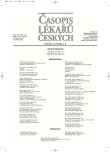Congenital Deficiency of FVII and Acquired Idiopathic Thrombocytopenic Purpura – the Rare Combination of Two Bleeding Disorders
Authors:
J. Šlechtová
Authors‘ workplace:
Ústav klinické biochemie a hematologie LF UK a FN, Plzeň
Published in:
Čas. Lék. čes. 2008; 147: 431-433
Category:
Case Report
Overview
The congenital deficiency of FVII is an autosomal recessive rare disorder. We have observed 15 patients with this deficiency in our haematology department including the only one patient with the FVII level < 1%. The deficiency with the FVII level < 2% is associated with serious bleeding complications including the joint bleeding, bleeding in the retroperitoneum, gastrointestinal system and in central nervous system (CNS). Serious acquired thrombocytopenia can originate from the impairment of platelets production, from their higher sequestration in the spleen but even from the elevated thrombocytes disintegration. The raised thrombocytes disintegration caused by the autoantibodies is the most frequent source of the acute life threatening thrombocytopenia with the massive bleeding in tissues, gastrointestinal system or CNS. We list the case report of a young patient with congenital FVII deficiency (FVII level < 1%) and acute idiopathic thrombocytopenic purpura with yet unknown aetiology of which has not been fully clarified although the very favourable effect of prednisone therapy indicates the autoimmune mechanism.
Key words:
congenital deficiency of FVII, idiopathic thrombocytopenic purpura, haptoglobin.
Sources
1. Friedman, K. D., Rodgers, G. M.: Inherited Coagulation Disorders,. Wintrobe’s Clinical Hematology (11th edition) Lippincott Wiliams & Wilkins, 2004, s. 1620-1667
2. Penka, M., Buliková, A., Matýšková, M., Zavřelová, J.: Hematologie I, neonkologická hematologie. Praha, Grada Publishing, 2001, s. 101–117, s. 137–138.
3. Berkow, R., Fletcher, A. J. et al.: Kompendium klinické medicíny. Krvácivé poruchy. Praha, X-Egem, 1996, s. 1057–1068
4. Cetkovský, P. et al.: Intenzivní péče v hematologii. Praha, Galén, 2004, s. 268–269
5. Koda, Y. et al.: Simple PCR detection of haptoglobin gene deletion in anhaptoglobinemic patiens with antihaproglobin antipody that cause anaphylactic transfusion reactions. Blood, 2000,95, s. 1138–1143.
6. Shimada, E. et al.: Anaphylactic transfusion reactions in haptoglobin-deficient patiens with IgE and IgG haptoglobin antibodies. Transfusion, 2002, 42, s. 766–773.
Labels
Addictology Allergology and clinical immunology Angiology Audiology Clinical biochemistry Dermatology & STDs Paediatric gastroenterology Paediatric surgery Paediatric cardiology Paediatric neurology Paediatric ENT Paediatric psychiatry Paediatric rheumatology Diabetology Pharmacy Vascular surgery Pain management Dental HygienistArticle was published in
Journal of Czech Physicians

Most read in this issue
- Congenital Deficiency of FVII and Acquired Idiopathic Thrombocytopenic Purpura – the Rare Combination of Two Bleeding Disorders
- Analytical Methods at the Boundary between Biochemistry and Immunology
- Medical Doctors and Nurses – a Dialogue about their Professional Roles and Competences
- Long-term Improvement of Fasting Glycaemia after Switching Basal Insulin from NPH to Determir in Children with Type 1 Diabetes: A 1-Year Multicentre Study
